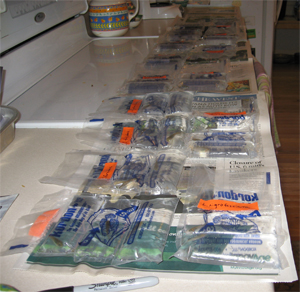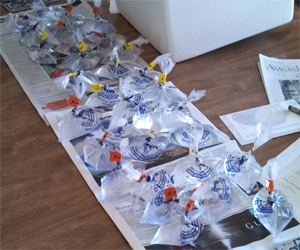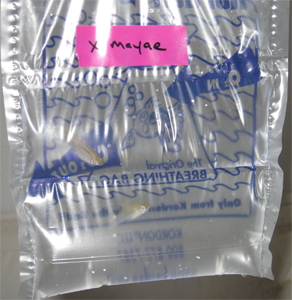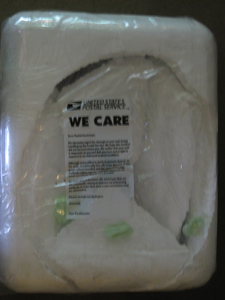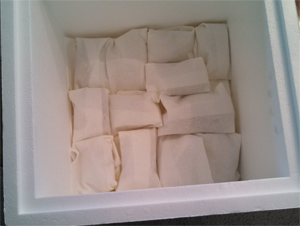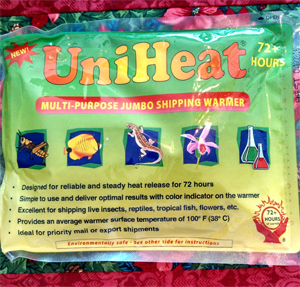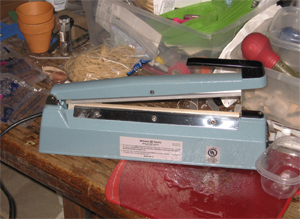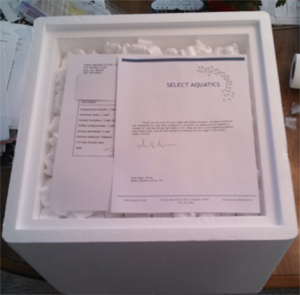|
As a small business doing a fair amount of shipping, there are
many basic practices that I follow to make the job easier,
simpler, consistent, and
where near total control of each fish’s survival can be addressed.
Granted, giving a box up to
the postal service to be
shipped comes with risk, but that can be minimized through care when
initially packaged, so that
if a disaster should
happen, all or most of the fish will still survive. The most common
disasters encountered have been
boxes lost in transit for over a week, and the
occasional box that gets smashed or damaged by mishandling.
To keep expenses down I use only USPS, which 99% of the
time has done an excellent job.
At Select Aquatics, all of the best husbandry, breeding and care is moot if the
fish don’t reflect all that work when a
customer opens the
box. Fish that arrive looking malnourished or “hanging on” as the result
of a poor shipping experience
wasn’t going to meet the
minimum standard I aimed for.
Obviously, assuming each box would lose "a couple", as many
shippers do, didn’t seem warranted if they were packed correctly. I
set out to achieve the highest proportion of fish arriving
alive, that looked good, were minimally stressed, and had
the best chances of adjusting well to their new environment.
I also strived to keep shipping costs to a minimum- not
by cutting back on any services or shipping times, but through
changes made to the shipping and bagging process that
would dramatically cut water weight, allowing for more fish
per box, and if possible, in a way that was actually
better for the fish.
The Post Office - The
Good
Boxes are shipped one of
two ways, 3-5 day Priority Mail, and Overnight Express Mail. Except for
holiday periods, a
Priority box generally
arrives second day- about 80% of the time, the rest usually arrive the
following day. A box
shipped on Monday arrives
on Wednesday. The best time to ship a Priority box is on a Saturday-
there is not as much
box traffic, and packages
still move over the weekend (Except holidays). Shipping on a Monday
results in the largest
number of boxes arriving
a 3rd or 4th day later.
There are other delivery
service options, but they are much more expensive. A recent 4 lb.
Styrofoam box needed to go
overnight to southern
Texas. The customer asked that I comare USPS and UPS. Though I ship all
of my styrofoam boxes
with USPS as they are,
UPS required that I pay $9 to put the Styrofoam container into a
cardboard box before it could
be shipped. Then, to go
overnight, the cost was $106. So to ship this 4 lb. box would cost $125.
I then took the same
box to USPS, who accepted
it as is, and the total cost for overnight shipment was $38. So I have
yet to use UPS. When
a customer has requested
UPS- which has happened three times, all three went with USPS when told
of the price options.
FedEx substations no
longer accept live fish, though with prearrangement I am told FedEx will
still accept live fish
at the airport station.
DHL and other shipping generally do not ship live fish, or are
prohibitively expensive.
Because of colder temps.,
heavy box traffic and the potential for packages being handled more
roughly, and lost more
frequently, I have not
shipped fish from about mid- November to mid-January.
To ship a 5 lb. box, approximately 12 x 14 inches, 3-5 day
Priority Mail, within the continental US costs about $15- 25
depending on the
destination. This amounts to 8 to 10 1- 1.5 inch fish in my channeled
breather bags. The same box
overnight runs $32- 45.
With each addition of 2-3 fish the price roughly goes up about $4-5.
Rates go up as distance,
the weight and the size
of the box increase. Overnight delivery is generally guaranteed by noon
or 3pm., provided the
box is delivered to the
originating post office by a certain time. A box dropped off at 4:50pm,
for example, is likely
not going to make a next
day overnight delivery. You will need to check when the pickup occurs at
your post office.
Particularly if you are
using a heat pack, you do not want the box to sit at room temperature at
the post office waiting
to go out for any period
of time.
Many post offices,
however, do not guarantee overnight delivery under any circumstances due
to their distance from a
main hub, and I run
across 1-2 destinations a month where overnight delivery is not
guaranteed. Often, the box arrives
next day to the
destination post office, but does not arrive in time to make it out for
delivery to your destination,
and the box can be picked
up from the post office the next day by notifying the post office, and
having them pull it
for pick up for you.
The Post Office - The Occasional Reality
Like many people that have tried shipping fish through
the Post Office, the clerk that shakes a box, then asks
if the box contains
water, and then refuses to ship it, has been all too
commonplace. At one point, in fact, I
vowed never to again set
foot in another post office after the third time I was taken to
a side room and
questioned about my box
that contained water, in post offices on the east coast. Today I
know that I had simply
encountered uninformed
and poorly trained people that were not interested in listening
to my explanations.
Shipping fish was
something I was often told, by Post Office clerks, wasn't
possible. Not winning by trying to
explain to the Post
Office what will ship and what won't, I would take the box and
ship it, the same Postal service,
no questions asked,
through a 3rd party discount shipping service (Such as Boxes
etc.). I had not shipped a
box from the Post Office
for over 20 years because of those experiences.
I have found that if you
are having a problem with your post office accepting your
appropriately packaged boxes
of live fish it will come
down to establishing a personal relationship. It shouldn't, but
it does. Most post offices
are fine and will ship
your box without a problem. Not wanting to find myself in a
possible scene on my first attempt,
once it was known I would
be shipping regularly I set up a meeting with my local post
office. I told them of my
past experience and asked
to do business with them. There is nothing wrong with shipping
fish by the post office.
It's legal, it's done
routinely.
Today everyone in my
small town post office knows me as the fish shipping guy, and it
always goes well. Yet I have a
friend the very next town
over who ships cichlids, and he now drives to my post office to
mail his fish, as his post
office refuses to take
any of his boxes. Unfortunately, fish shipping is still
infrequent enough that you could be
treated as a new
situation by your post office (you may simply want to to stop by
and talk to someone ahead of time
to pave the way for
yourself). The Post office is great, and I could not begin to do
what I do without their service
and rates. But facing new
situations in these fearful times of terrorism is not one of
their strengths. Even when it
involves following their
own policies.
A big step forward is to
use the breather bags. Tied off without any air in the bags, the
box does not slosh as it
does with standard
plastic bags that contain air. Without the slosh, the box can
often be shipped easily without
being questioned. Because
of all this, it has only been recently that I have begun to
attach "Live Fish" labels to
the box, no longer
concerned the box will not be accepted, or intercepted in
shipment. Now as a licensed fish
shipper I should finally
be beyond question. I do recommend placing "Fragile" or "Handle
With Care" labels
on the box
_______________________________________________________________________________________
What are the losses? To
better provide a guarantee of live delivery, a formula of extras
was worked out that
covers any fish that may
be lost in transit. Essentially, if a customer buys 2 pair, I will send
a third, if he/she
purchases a pair, I will
send a trio. Losses now are minimal during the warmer months- 1-2 fish
every 20 or so boxes,
but during colder weather
it will increase to 1-2 fish every 7-10 boxes. I decided to raise the
fish here in large
numbers, so that
customers only receive the best quality fish, and I am protected if
there should be a problem with a
single tank or two. and
for me to send an extra or two is not a loss to the business. As well, I try to keep
the fish being shipped to
2 inches or less, to both save the customer money for shipping, and give
the fish
the best odds at making
the trip comfortably.
Some Basic Rules of the Game:
- The post office
requires that the water is contained within the box with a double
barrier. Double bagged, or bags
in another
bag. With breather bags, that really isn’t an option, so you make every
effort to ensure that if a bag were to
leak, the
water released is minimal.
- The box must be sturdy
and well sealed with clear shipping tape. I only use Styrofoam boxes
from previous
shipments
sent to me, or collected from any number of places such as hospitals,
doctor’s offices, local colleges that do
research,
etc. Styro boxes are simply far too expensive to buy and ship to you
online.
- The fish must not be
fed for 1-2 days prior to shipping.
- The fish must be
“comfortable” to survive. A large bag sitting directly on the bottom of
the box can break when
dropped, or
when the bottom is slammed for any reason. So for example, a layer of styro
peanuts is first put down
to cushion the bottom
should there be an impact. Avoid starch peanuts,
as the slightest leakage of water will
cause them to
break down. If you are not sure, simply drop one in a glass of water and
it will dissolve.
- Fish can be shipped
year around when temps are roughly between 35 and 90 degrees. Heat packs
and cold packs
come into
play at the outer temperature extremes. Overnight delivery is recommended in
those circumstances.
The Fish do best when:
- They are individually
bagged. Not only do males of some species not attack or kill companions
in the crowded confines
of a bag, but
one dying in the bag does not create an ammonia bloom that can kill off
the rest of the fish.
- They have enough room
to maintain the ability to rest easily in the bag. It isn’t necessary
that they be able to turn
around.
I do use regular aquarium
plastic bags when shipping larger fish or fish with spines that may
puncture a breather bag
(such as catfish).
Breather bag
requirements:
- Breather bags are a bag
where the plastic walls of the bag are “semipermeable” in that the bag
itself continuously
exchanges
clean air and dissolved oxygen into the bag. When a bag is used, the
fish is put into a small amount of
water- just
enough to meet their needs, WITHOUT any air in the bag. Most people tie
a knot to close the bag. The result
is a solid
ball of water with the fish inside, with no air in the bag at all. The
bag doesn’t slosh, the fish isn’t
banged around
against the sides, and the oxygenation function of the bags works so
well that fish in similar amounts
of water (or
even a little more) do not do as well in a standard, tied,
plastic aquarium bag.
- The breather bags must
not be allowed to touch one another or get wet as doing so will
compromise the oxygen
exchange
ability.
- I use a
Midwest-Pacific impulse sealer, bought from Grainger, Inc., that allows
me to seal each fish within a
channel
within the breather bag. For example, with a 5 x 8 bag I can seal in 3
smaller fish in the space of a
single
bag. Some people have done the same with food sealing units bought at
local appliance stores. My sealer
cost
about $130, but I have been told they are available used on Ebay for
much less. I did find that my losses
increased slightly when the breather bags were used this way- chambers
do occasionally leak, and for this reason
I still
use the chamber method, especially with smaller fish, but not as
extensively as I did at first.
- The breather bags are very thin,
but surprisingly durable. I have found that chafing from the edges of
newspaper
or other
packing materials can cause the bags to leak if handled roughly enough-
so the breather bags only come in
contact with
a particularly soft brand of paper towel- I use the Viva brand. The
channeled bags can be layered within
the paper
towels, or with larger fish where there is only one fish per bag, each
bag can be gently wrapped and laid into
the box next
to one another in what a customer called the “tamale method”, again
layered between paper towels and
styro
peanuts. (See pics below)
- After being sealed into
the breather bags, and before being put into the shipping box, all of
the bags are placed
on dry
newspaper, and each is turned after 10-15 minutes, looking for possible
leaks. Any that leak are put into new bags
before being
shipped.
- How much water? In the
breather bags I usually figure there should be enough water in the bag
so that the fish can
turn around,
and it should be roughly as deep as the fish is long. This is not a lot
of water, but it truly is all that
they need.
|
 |
